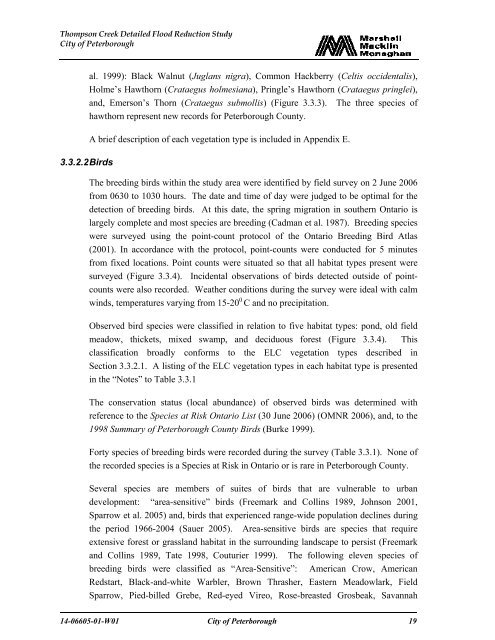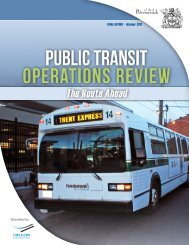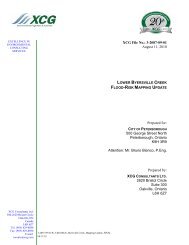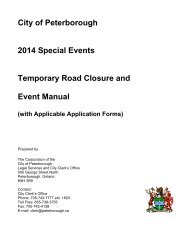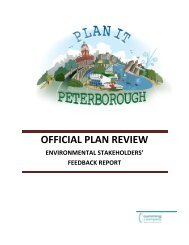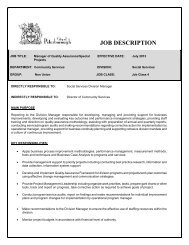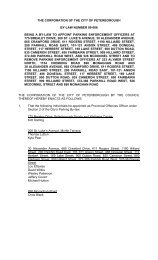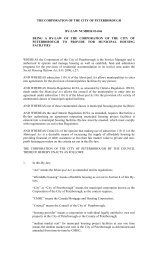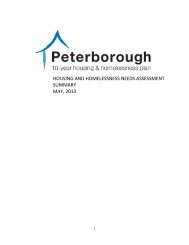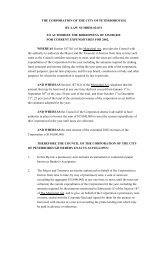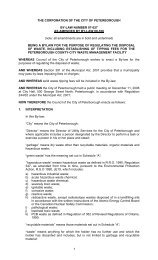Thompson Creek Flood Study Report - City of Peterborough
Thompson Creek Flood Study Report - City of Peterborough
Thompson Creek Flood Study Report - City of Peterborough
Create successful ePaper yourself
Turn your PDF publications into a flip-book with our unique Google optimized e-Paper software.
<strong>Thompson</strong> <strong>Creek</strong> Detailed <strong>Flood</strong> Reduction <strong>Study</strong><br />
<strong>City</strong> <strong>of</strong> <strong>Peterborough</strong><br />
3.3.2.2 Birds<br />
al. 1999): Black Walnut (Juglans nigra), Common Hackberry (Celtis occidentalis),<br />
Holme’s Hawthorn (Crataegus holmesiana), Pringle’s Hawthorn (Crataegus pringlei),<br />
and, Emerson’s Thorn (Crataegus submollis) (Figure 3.3.3). The three species <strong>of</strong><br />
hawthorn represent new records for <strong>Peterborough</strong> County.<br />
A brief description <strong>of</strong> each vegetation type is included in Appendix E.<br />
The breeding birds within the study area were identified by field survey on 2 June 2006<br />
from 0630 to 1030 hours. The date and time <strong>of</strong> day were judged to be optimal for the<br />
detection <strong>of</strong> breeding birds. At this date, the spring migration in southern Ontario is<br />
largely complete and most species are breeding (Cadman et al. 1987). Breeding species<br />
were surveyed using the point-count protocol <strong>of</strong> the Ontario Breeding Bird Atlas<br />
(2001). In accordance with the protocol, point-counts were conducted for 5 minutes<br />
from fixed locations. Point counts were situated so that all habitat types present were<br />
surveyed (Figure 3.3.4). Incidental observations <strong>of</strong> birds detected outside <strong>of</strong> pointcounts<br />
were also recorded. Weather conditions during the survey were ideal with calm<br />
winds, temperatures varying from 15-20 0 C and no precipitation.<br />
Observed bird species were classified in relation to five habitat types: pond, old field<br />
meadow, thickets, mixed swamp, and deciduous forest (Figure 3.3.4). This<br />
classification broadly conforms to the ELC vegetation types described in<br />
Section 3.3.2.1. A listing <strong>of</strong> the ELC vegetation types in each habitat type is presented<br />
in the “Notes” to Table 3.3.1<br />
The conservation status (local abundance) <strong>of</strong> observed birds was determined with<br />
reference to the Species at Risk Ontario List (30 June 2006) (OMNR 2006), and, to the<br />
1998 Summary <strong>of</strong> <strong>Peterborough</strong> County Birds (Burke 1999).<br />
Forty species <strong>of</strong> breeding birds were recorded during the survey (Table 3.3.1). None <strong>of</strong><br />
the recorded species is a Species at Risk in Ontario or is rare in <strong>Peterborough</strong> County.<br />
Several species are members <strong>of</strong> suites <strong>of</strong> birds that are vulnerable to urban<br />
development: “area-sensitive” birds (Freemark and Collins 1989, Johnson 2001,<br />
Sparrow et al. 2005) and, birds that experienced range-wide population declines during<br />
the period 1966-2004 (Sauer 2005). Area-sensitive birds are species that require<br />
extensive forest or grassland habitat in the surrounding landscape to persist (Freemark<br />
and Collins 1989, Tate 1998, Couturier 1999). The following eleven species <strong>of</strong><br />
breeding birds were classified as “Area-Sensitive”: American Crow, American<br />
Redstart, Black-and-white Warbler, Brown Thrasher, Eastern Meadowlark, Field<br />
Sparrow, Pied-billed Grebe, Red-eyed Vireo, Rose-breasted Grosbeak, Savannah<br />
14-06605-01-W01 <strong>City</strong> <strong>of</strong> <strong>Peterborough</strong> 19


